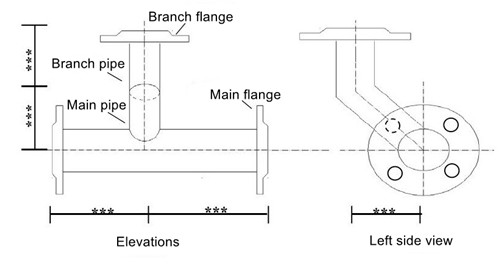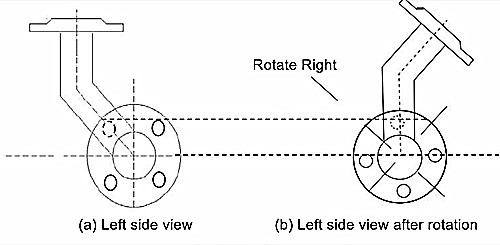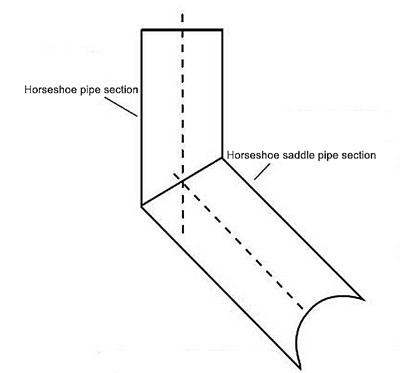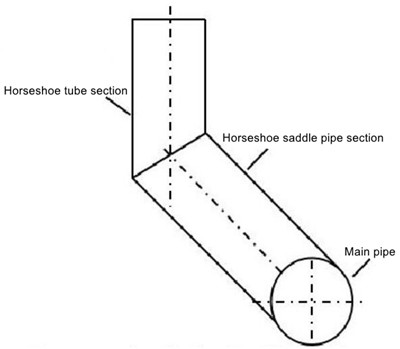Do this individually Piping system design to ensure the production accuracy of the customized piping system and meet relevant quality requirements.
0. Preface
In the construction company's second technical game in 2023, the design of manufacturing custom piping systems was added to the oil and gas pipeline installer exam questions. This production method is rarely used in field production, so it is necessary to use more sophisticated production methods. Improve the qualification level of field operators and ensure that the production of customized piping systems is In accordance with the quality requirements, in the production of various types of pipe fittings, the following methods are ultimately determined, which can guarantee the production accuracy of pipe fittings while taking into account the design efficiency.
1. Difference between molded pipe fittings and traditional pipe fittings 
Figure.1 Custom Piping Systems Figure
Figure 1 shows a diagram for a custom piping system. In the illustration, the branch and main connections are still connected with a saddle connection. Branches and main connections follow the traditional branch example drawing method and are grouped according to the prefabricated installation principle. However, as can be seen on the left side of the diagram, there are differences from the traditional three saddle connections.
Difference 1: In traditional pipe connections, the flange holes branch at both ends of the main section of the crossline at the vertical intersection of the connection; there is no angular deviation; In molded pipe joints, there is an angular deviation in the branches and flange holes at both ends of the transverse line, and the angle changes with the size and angle change.
The difference 2: In the traditional production of pipe joints, it is necessary to use the corresponding group measuring tools to correct the perpendiculars of the side horizontal line of the branch pipe and the hole of the main and main flange at both ends. However, in group prefabrication of shaped pipe joints, it is necessary to simultaneously take into account the verticality of the branch and main pipe, while controlling the lateral dimensions of the left side and the deviation angle. This complicates the manufacture of these connections, particularly in prefabrication of group connections, whose size and angle cannot be precisely controlled. Precise control of size and angle inevitably affects the quality of pipeline prefabrication .
2. Production method
(1) Branch expansion diagram drawing
The drawing method for unfolding molded pipe fitting samples and the traditional drawing method are the same. Depending on the training process or experience in the area, the sampling method required for production is broken down for the reasons shown in Figure 3. 
Figure 2: Molded tube connections branch to extend prototype schematic diagram
As can be seen from Figure 2, the branch in Figure (a) is rotated to the right at a certain angle, while the branch in Figure (b) is perpendicular to the horizontal axis of the main section. Therefore, the design of the molded branch to expand the prototype must also conform to the previously learned expansion design method. The inclination angle of the extension does not need to be taken into consideration, but the quality of the prototype extension design must be strictly controlled. In a similar way, the horseshoe-shaped branch mouth is also drawn in the unfolding design.
(2) Cutting material
The branch pipe section is divided into four equal parts of the same size, with a needle to connect the tubes, and 8 sample eyelets are punched into the tube ends of the tube parts of the same size. Draw a saddle and horseshoe mouth to extend the sample into the centerline drawing of the tube section on the scribe material. The 4 isometric lines of the extended sample must coincide one by one with the isometric line of the tube section and must not deviate. These are cutting operations. Before cutting, you should talk to gas welding personnel to explain the pipe position requirements and whether to cut the pipe or cut it to ensure that the pipe section size is not affected by cutting losses. Cutting must comply with standard pipe mouth grinding specifications.
(3) Prefabrication grouping 
Figure.3 Grouping of branched pipes
The production of pipe fittings should be divided into three group prefabrication parts, namely: group branch pipe part (horseshoe pipe section and saddle pipe section group), branch pipe part of the group with branch pipe and flange group.
1) Branch pipe part (horseshoe branch pipe section and saddle pipe section) prefabricated grouping, see Figure 3.
The part of the group according to the pipe section in the drawing of the four equidistant lines of the corresponding group must not show deviation. The grouping must focus on the direction of the saddle tip to avoid deviations from the main direction.
2) Branch pipe and prefabricated main group, see Figure 4. 
Figure 4 Extension and main group
The prefabricated group in front of the main part should be evenly composed of four equal parts and reach the sample hole with a needle thread (the operation method and branch are the same for the same reason), determining the position of the group of Branch saddle according to the drawings, and not randomly group the size can be. To ensure that the construction requirements meet the map, there are two ways to determine the location of the branch saddle, namely: the calculation method and the sampling method.
Calculation method: Based on the drawings with Z and X dimensions, the branches and main deviation angle are determined by the trigonometric calculation method. The formula is: cosα = Z/X. Based on the deviation angle formula, it is grouped using the corresponding angle tool for grouping measurements. This method is difficult for operators who do not have clear knowledge of trigonometric functions, and grouping is more laborious; the quality of the cluster cannot be effectively guaranteed.
Soil sample placement method: Place the soil sample on the platform according to the size data provided in the drawing to reduce the deviation between the branch and main group and effectively guarantee the quality of the group (see Figure 5). 
Figure 5: Soil Sampling Method
Draw the cross at the center of the main tube and the outer diameter of the main tube. Then draw the corresponding sizes Z and X in the figure on the soil sample platform. The vertical line Z up (A) and the parallel line X to the right (B) result in the intersection C of the line AB. Connect point C to point O. The main tube crosses the outer diameter at point D. Draw a line parallel to point D of the main tube. This is the parallel line for the branch angle and the main deviation angle. Determine the installation position of the branch group based on the data of the parallel lines L and L1 on the elevation diagram. This method of determining the installation position of the group of branches in the soil sample is simple and easy to understand. You don't need to calculate any formulas. The on-site operator can quickly record essential processes. The most fundamental problem is being able to guarantee the quality of the group.
3) Flange parts grouping piece. After the two parts of the team are finished, according to the traditional flange part method, the flange part is an important link in the prefabricated flange part. The flange part needs to be checked when the pipe section is inserted into the depth of the flange and the height of the flange hole. With the precision of the flange part of the first flange part, the remaining two flanges can be made based on the flange part of the first flange part.
(1) Design the quality requirements of the deployment pattern
- 1) Testing of branch and main opening must be carried out with wall thickness treatment.
- 2) The length of the sample plate branch allows a deviation of ± 1 mm.
- 3) The branch tube and open hole sample plate are evenly distributed, allowing ±1mm deviation.
- 4) The sample plate must ensure that the curve is smooth.
(2) Undercutting requirements
- 1) To ensure the quality of prefabricated pairs, before cutting, the pair lines should be drawn on the corresponding section of the tube with a needle, and the samples should be pierced with eyelets at the end of the tube.
- 2) Before cutting, in gas welding, cutting requirements should be discussed with personnel to avoid cutting losses.
- 3) After cutting, it must meet the specification requirements for cleaning the pipe mouth.
(3) Prefabrication grouping requirements
- 1) Pipe segment gap tolerance is ±1mm.
- 2) Branch angle with permissible deviation of ± 1°.
- 3) Allowable deviation of flange hole parallelism ±1mm.
- 4) The perpendicularity of the flange and the pipe section may differ by ±1°.
- 5) Total prefabricated pairs of different dimensions with allowable deviation of ± 2 mm.
4. Precautions
- (1) Complete occupational safety equipment must be worn while working.
- (2) The correct use of surgical instruments to avoid accidents such as shocks and bruises.
- (3) When cutting and welding prefabrication groups, good safety glasses should be worn to avoid arc flash, splash and other eye injuries.
- (4) Be careful when handling materials and strictly avoid random placement.
- (5) After production is completed, the construction site must be cleaned in time to achieve a clean construction site with finished material.

























































